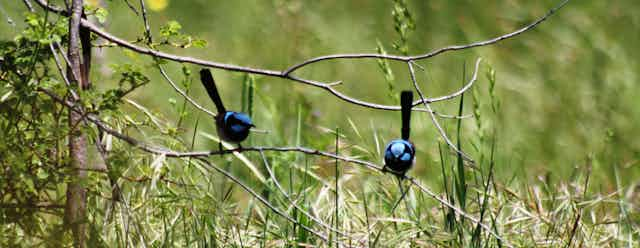Can superb fairy-wrens learn to respond to brood-parasitic cuckoos by simply watching other fairy-wrens react to a cuckoo? That’s the question posed in a new Biology Letters study by myself and Naomi Langmore of the Australian National University.
Obligate Brood parasites manipulate and use “hosts” – from different species – to raise their young. Such parasitism is the breeding strategy of approximately 1% of the 10,000 or so bird species, and most notably comprises cuckoos.
Brood parasitism by cuckoos is costly to the host: cuckoos, such as the Australian bronze-cuckoo remove a host’s egg and replace it with their own egg. Upon hatching, the young cuckoo, so young that its eyes have not yet opened, heaves the remainder of the host brood, one after another, out of the nest, gaining itself exclusive attention from its unfortunate, unrelated foster parents.
In turn, hosts attempt to defend themselves against parasitism by cuckoos. Superb fairy-wrens, the primary host of the Horsfield’s bronze-cuckoo and a secondary host of the shining bronze-cuckoo in south-eastern Australia, recognise and attack adult cuckoos and abandon cuckoo chicks.
If an adult cuckoo is in the area while a fairy-wren is breeding, its likelihood of successfully abandoning a cuckoo chick increases – so recognition of adult cuckoos by potential hosts is important.
But previous work in this system has demonstrated that recognition of cuckoos is not innate, and therefore must be learned; and cuckoos are discreet, giving hosts few opportunities to learn what they are and the threat they pose.

Social learning
While hosts could learn about cuckoos by experience, an alternate process by which hosts could obtain information about how to identify and respond to cuckoos is social learning (simply, learning by observing). This is not a new idea: several excellent studies have inferred that social learning is a way by which European reed warblers may learn and adjust their response to common cuckoos.
But no previous study has experimentally demonstrated this learning process by naive hosts of cuckoos, which was the aim of this study.
What we did
Our Biology Letters study took place in Campbell Park, Canberra, Australia. Horsfield’s and shining bronze-cuckoos are migratory birds, generally arriving after the fairy-wren breeding season starts (August), and leaving before it ends (January).

This allowed us to identify, colour band and monitor individual fairy-wrens that hatched following the departure of cuckoos in late 2011 for experimentation before cuckoos arrived again in later 2012 (11 individuals).
To ascertain the response of fairy-wrens to cuckoos, we used “model presentation” experiments – a method that comprises presenting a taxidermied (or in this study freeze-dried) model of a cuckoo to the target individuals, or group and noting their behavioural response.
Each experimental trial comprised two sets of three treatments:
1) presentation of the model to the naive individual (fairy-wren) when it was alone (pre-training)
2) presentation of the model to the entire group of fairy-wrens (training)
3) presentation of the model to the (previously) naive individual again (post-training).
One set of treatments was performed using the cuckoo model, while the other used a honeyeater (a harmless control). Honeyeaters are also resident birds, so the purpose of this control was to identify whether a change in response in the pre- versus post-training trial was a result of learning, or change in response as a result of repeated presentations.
The models were placed in a protective cage and covered with a camouflage cloth. This allowed us to pull the cloth off the cage and reveal the model to the naive individual in the pre- and post-training trials. All trials were conducted approximately two metres from the host nest after completion, but prior to laying by the host in the nest when cuckoos are a threat.
All our trials were recorded with a microphone to allow analysis of the vocal data in the lab, and the behavioural response was simultaneously dictated.
What we found

In the pre-training trial the naive individual didn’t make any alarm calls and showed no aggressive behaviour towards the cuckoo model. In one instance a naive fairy-wren hopped up to the cage that housed the cuckoo, and then hopped to, and sat on the nest.
But following the training trial, in which the experienced individuals were vigorously aggressive to the cuckoo, the (previously) naive individuals made whining and mobbing alarm calls and vigorously mobbed the cuckoo.
By contrast, there was no change in response to the honeyeater, suggesting social learning is a process by which fairy-wrens learn to recognise and respond to cuckoos.
Why it matters
To superb fairy-wrens, the cost of hosting a brood parasite likely outweights the cost of nest predation (predation of the nest content): both eradicate its brood, but parasitism carries the additional cost of raising an alien.

Recognition of a cuckoo aids fairy-wrens by facilitating an aggressive response in which they may prevent parasitism from occurring, or by obtaining information that may be used to assist in the decision to abandon the cuckoo chick.
Our study demonstrates that fairy-wrens, and presumably other cuckoo hosts, can rapidly learn adaptive information about a cuckoo without having to learn what a cuckoo is through experience.
As fairy-wrens are cooperative breeders, the benefits associated with the rapid transmission of information may be amplified in larger breeding groups, possibly better equipping those groups to deter parasitism.
But this possibility remains to be tested, as does the intuitive next question: how does the first bird in a population learn about a cuckoo?

